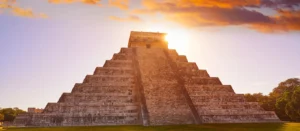Discover the Mayan Ruins of Chichen Itza: A Journey into Ancient Mexico
Chichen Itza stands as one of the most iconic and well-preserved archaeological sites in Mexico, offering a fascinating glimpse into the grandeur of Mayan civilization. Located in the Yucatan Peninsula, this UNESCO World Heritage Site attracts millions of visitors each year who are eager to explore its impressive structures, learn about Mayan history, and marvel at its architectural ingenuity. Embark on a journey to discover the ancient Mayan city of Chichen Itza and uncover the secrets of this archaeological wonder.
The Significance of Chichen Itza in Mayan History
Chichen Itza was a major political, economic, and religious center during the Late Classic and Terminal Classic periods (roughly AD 750-1200). Its strategic location facilitated trade routes across the Yucatan Peninsula and beyond, making it a hub for cultural exchange among different Mesoamerican civilizations. The site’s impressive architecture reflects a blend of Maya and Toltec influences, showcasing the region’s rich cultural diversity.
El Castillo (The Pyramid of Kukulcán)
Arguably the most famous structure at Chichen Itza is El Castillo, also known as the Pyramid of Kukulcán. This step pyramid served as a temple dedicated to the serpent deity Kukulcán. Its design is not only visually stunning but also scientifically significant; during the equinoxes, sunlight creates an illusion of a serpent descending or ascending the pyramid’s staircase—symbolizing Kukulcán’s return.
The Great Ball Court
Spanning approximately 168 meters long, the Great Ball Court is one of the largest and most elaborate ball courts in Mesoamerica. It was used for ceremonial ballgames that held religious significance, often associated with themes of life, death, and fertility. The walls feature intricate carvings depicting players and mythological scenes.
The Temple of the Warriors
This massive stepped pyramid is surrounded by columns adorned with carvings of warriors and deities. The Temple of the Warriors served both as a religious site and a military stronghold. Its impressive façade reflects Mayan craftsmanship and their complex belief systems.
The Observatory (El Caracol)
Unique among Mesoamerican structures, El Caracol is believed to have functioned as an astronomical observatory. Its circular tower aligns with celestial events such as solstices and equinoxes, demonstrating advanced knowledge of astronomy by ancient Maya astronomers.
Exploring Chichen Itza: Tips for Visitors
Best Time to Visit: The ideal time to explore Chichen Itza is during the dry season from November to April when weather conditions are more favorable.
Guided Tours: Hiring an experienced guide can enrich your visit by providing historical context, explaining symbolism behind structures, and sharing fascinating stories about Mayan culture.
Respect Preservation Efforts: As an important archaeological site, visitors should follow guidelines—avoid climbing on structures or touching carvings—to help preserve this heritage for future generations.
Early or Late Visits: To avoid crowds and heat, consider visiting early in the morning or late in the afternoon.
The Cultural Significance Today
Chichen Itza remains a symbol of Mexican heritage and indigenous history. Its iconic silhouette has become synonymous with ancient Mexico’s grandeur. Every year on March 21st (the spring equinox), thousands gather at El Castillo to witness a spectacular shadow display resembling a serpent—a celebration that connects modern visitors with ancient rituals.
Conservation Challenges
Despite its popularity, Chichen Itza faces challenges related to tourism pressure, environmental degradation, and natural erosion. Conservation efforts are ongoing to protect its structures through measures like controlled access zones and restoration projects. Supporting responsible tourism helps ensure that this archaeological treasure endures



